Repair plan for iconic crane after safety alert
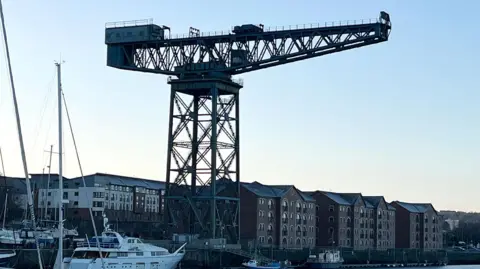 BBC
BBCUrgent repairs have been ordered on a giant Clydeside crane after fears the 107-year-old structure could be crumbling.
A safety exclusion zone was ordered beneath the Titan crane at Greenock's James Watt Dock in mid-December after reports of "material" landing on a boat in the nearby marina during high winds.
Heritage campaigners and local politicians have voiced concern that the category A-listed crane - one of only four surviving Titans on the Clyde - is not being properly maintained.
The crane's owners say an inspection found no parts were missing but remedial works will begin in the coming weeks to allow the exclusion zone to be lifted.
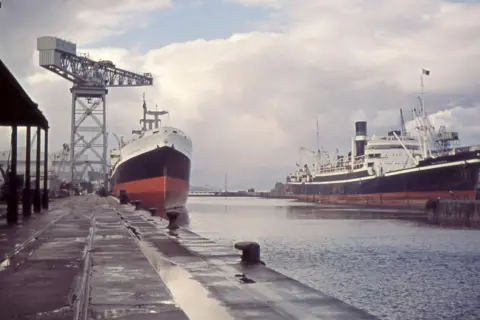 Inverclyde Heritage Network
Inverclyde Heritage NetworkThe Greenock Titan Crane was built in 1917 by Sir William Arrol & Co Ltd - one of the leading Glasgow engineering firms of the 19th and 20th Centuries.
The company built some of the UK's most famous steel structures, including the second Tay Bridge, the Forth Bridge and Tower Bridge in London.
The giant cantilever crane at Greenock stands 150ft (48m) tall and was once rated to lift 150 tonnes - the equivalent of about 30 adult elephants.
In Inverclyde's shipbuilding heyday it was used for lifting the heaviest objects into ships, particularly engines which were often made by the nearby Kincaid works.
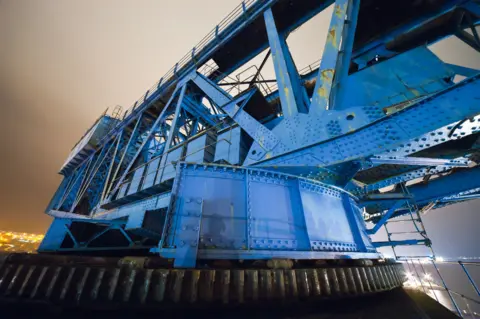 Transient Places
Transient Places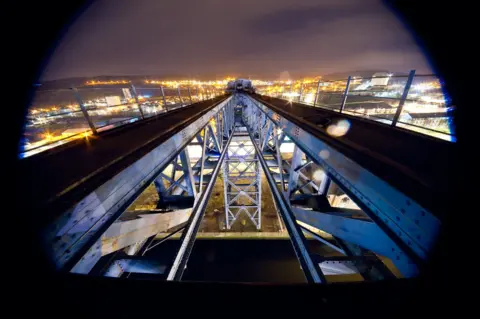 Transient Places
Transient PlacesThe crane's category A listing means it is considered to be of national or international significance for its architecture or history.
Elliott McKelvie, from Inverclyde Heritage Network, said he feared the crane might be allowed to deteriorate to such an extent that it has to be demolished.
Three smaller cranes beside the town's Inchgreen dry dock suffered a similar fate in 2017 when the owner, Peel, decided to blow them up.
"Greenock and Port Glasgow used to have a number of Arrol cranes in the shipyards but they're all gone," Mr McKelvie said.
"The Titan is the only one that's left and it's sad to see it fall into a state of disrepair where the paint's peeling off it and we're getting reports that it's unsafe."
Local politicians from the three largest parties have united in calls for action to preserve the crane.
It is owned by James Watt Dock LLP - a joint venture between subsidiaries of the Peel Group and publicly-funded urban regeneration firm Riverside Inverclyde.
Recently-elected local MP Martin McCluskey wrote to the owners asking for details on the condition of the crane and plans for its preservation.
"The water in Inverclyde is one of our biggest assets whether that's industry or tourism," he told BBC Scotland News.
"We have a growing cruise ship market - we need to be thinking about all of these things on how we cater for a growing market for tourism.
"It could easily be a tourist attraction, although that would require a lot more investment and thought."
Repair plan
Brian Lavelette, property director for Peel Waters and a member of the James Watt Dock board, said a survey was ordered immediately after the first reports of falling debris 17 December.
"Our contractors were able to safely access the crane and observed that they could see no part of the crane missing," he said in a new update.
"We have invested hundreds of thousands of pounds over recent years towards the maintenance on the crane and as part of our ongoing commitment to its upkeep we have approved a full works proposal provided by specialist contractors with works due in the next couple of weeks.
"Once these works are completed and subject to a further survey which is satisfactory to all parties, the intention is to remove the exclusion zone and withdraw the Notice to Mariners."
Where are the other Titans?
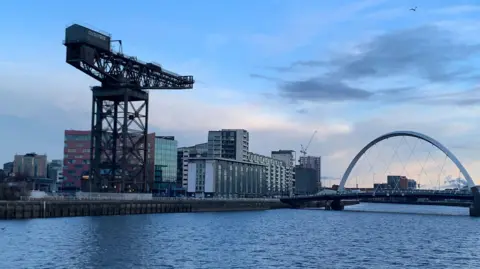 Getty Images
Getty ImagesThe best known Titan is the Finnieston crane in central Glasgow, which has become an emblem of the city's industrial past.
A few miles downriver, the Clydebank Titan crane - at the site of the former John Brown shipyard - has been turned into an award-winning visitor attraction with lift access but it is currently closed.
A fourth giant cantilever crane stands at Whiteinch in Glasgow at the site of Barclay Curle shipyard while a fifth Titan in Govan was demolished in 2007 to allow development of the BAE Systems shipyard,
In the east of the country, the Rosyth Titans were taken down in the 1990s.
More than 40 similar cranes were manufactured worldwide, most of them designed by Sir William Arrol & Co Ltd.
One Titan, built by Scottish firms in 1907, still stands in the Japanese city of Nagasaki having survived the second wartime use of an atomic bomb in 1945.
